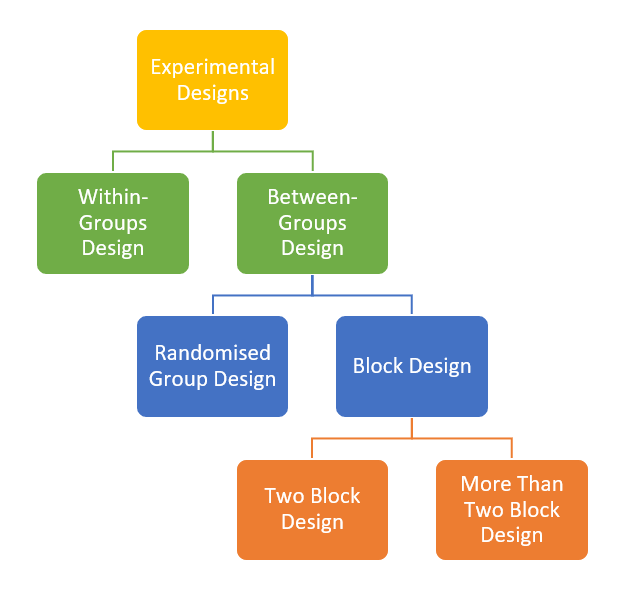Introduction
Experimental designs form the backbone of rigorous scientific research. They allow researchers to manipulate independent variables, control for confounds, and determine causality. Two fundamental types of designs are between-groups designs (including randomized groups and block designs) and within-groups designs (also called repeated measures designs).

Between-Groups Designs and Within-Group Designs
1. Between-Groups Designs
In between-groups designs, different groups of participants experience different levels of the independent variable. Each participant contributes data to only one experimental condition. Two major types include- randomised group design and block design
Randomized Groups Design (Completely Randomized Design)
This design is widely used due to its simplicity and strong control over confounding variables.
Key Features:
- Random assignment: Participants are randomly assigned to different groups, each receiving a unique condition.
- Independent groups: Each participant contributes data to only one group.
- Comparisons: Differences in the dependent variable across groups reveal the effects of the independent variable.
Control Techniques:
- Randomization: Minimizes bias and evenly distributes participant characteristics.
- Standardization: Ensures identical procedures, materials, and conditions across groups.
- Blinding: Reduces expectancy effects and biases.
- Manipulation checks: Confirm that the independent variable was effectively implemented.
Example:
In Dittmar et al. (2006), girls were randomly assigned to play with a Barbie doll (thin-ideal), an Emme doll (average-sized), or no doll (control). Random assignment and standardized procedures controlled confounds, enabling conclusions about Barbie doll exposure and body image dissatisfaction.
Block Designs
Block designs are extensions of the randomized groups design, adding a layer of control for known confounding variables.
Two-Group Block Design
A two-group block design is an experimental design used to control for the effects of known confounding variables. In this design, participants are first divided into groups, or “blocks,” based on a relevant characteristic (the blocking variable), such as gender, age, or baseline performance. This ensures that each block contains participants who are similar on the confounding variable
- Blocking variable: Participants are grouped (blocked) by a confounding variable (e.g., age, gender, prior ability).
- Randomization within blocks: Within each block, participants are randomly assigned to one of two conditions (e.g., treatment or control).
Example: In a study on teaching methods, students might be blocked based on prior academic performance (low/high) and then randomly assigned within each block to traditional or new methods.
Read More- Reliability in Testing
Randomized Block Design with More Than Two Groups
A randomized block design with more than two groups extends the two-group block design to accommodate multiple experimental conditions. As with the two-group version, participants are first divided into blocks based on a confounding variable, ensuring that each block consists of individuals who share similar characteristics, such as age, gender, or prior experience.
- Blocking variable: Participants are grouped by a confounding variable.
- Random assignment within blocks: Within each block, participants are randomly assigned to one of multiple groups.
- Multiple conditions: Used when there are more than two experimental groups.
Example: A trial comparing three therapies for anxiety, blocking participants based on baseline anxiety (low/moderate/high) to ensure balanced distribution across therapies.
Advantages of Block Designs:
- Control for known confounds: Reduces variability due to blocking variables.
- Increased precision: Greater statistical power to detect treatment effects.
Limitations of Block Designs:
- Requires knowledge of confounds.
- More complex design and analysis.
2. Within-Groups (Repeated Measures) Design
In within-groups designs, also called repeated measures designs, the same participants are exposed to all experimental conditions. This design contrasts with between-groups approaches and offers unique strengths and challenges.
Key Features:
- Each participant serves as their own control: Reduces error variance due to individual differences.
- Conditions experienced by all: Participants undergo each level of the independent variable, either in a counterbalanced order or randomized.
- Fewer participants needed: Since each participant contributes data to all conditions.
Control Techniques:
- Counterbalancing: The order of conditions is varied across participants to control for order effects (e.g., fatigue, learning, practice effects).
- Randomization of order: Minimizes systematic bias.
- Washout periods: Time between conditions reduces carryover effects.
- Practice sessions: Familiarizes participants with procedures to reduce learning effects.
Example:
A cognitive psychologist tests the impact of three different types of memory training on recall ability. All participants complete tasks under each training condition, with the order of tasks counterbalanced across participants.
Advantages of Within-Groups Designs:
- Greater statistical power: Reduces error variance related to individual differences.
- Efficient: Requires fewer participants than between-groups designs.
- Sensitivity to effects: More likely to detect subtle differences between conditions.
Limitations of Within-Groups Designs:
- Order effects: Fatigue, practice, or carryover effects can confound results.
- Demand characteristics: Participants may guess the experiment’s purpose.
- Complex analysis: Requires advanced statistical techniques (e.g., repeated measures ANOVA).

Experimental Designs
Conclusion
Between-groups designs, including randomized groups and block designs, are powerful tools for isolating the effects of an independent variable on an outcome, especially when confounds are well-controlled. Within-groups (repeated measures) designs, on the other hand, enhance statistical power and reduce participant variability by having each participant experience all conditions. However, they introduce challenges such as order effects and demand characteristics.
The choice between these designs depends on research goals, the nature of the independent variable, practical constraints, and statistical considerations. A clear understanding of both designs equips researchers to select the most appropriate method for drawing valid and reliable conclusions.
References
Dittmar, H., Halliwell, E., & Ive, S. (2006). Does Barbie make girls want to be thin? The effect of experimental exposure to images of dolls on the body image of 5- to 8-year-old girls. Developmental Psychology, 42(2), 283–292. https://pubmed.ncbi.nlm.nih.gov/16569167/
Shaughnessy, J. J., Zechmeister, E. B., & Zechmeister, J. S. (2014). Research methods in psychology (10th ed.). McGraw-Hill Education.
Singh, A. K. (2006). Tests, measurements and research methods in behavioural sciences. Bharati Bhawan.
Subscribe to Careershodh
Get the latest updates and insights.
Join 18,556 other subscribers!
Niwlikar, B. A. (2025, June 6). 2 Important Between-Groups Designs and Within-Group Designs. Careershodh. https://www.careershodh.com/between-groups-designs/
